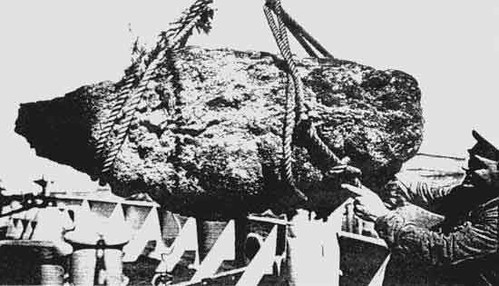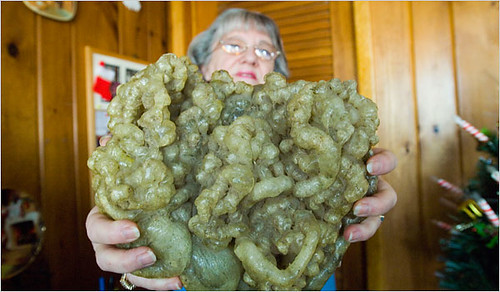‘It is a marine Sulphur, found at the Sea-Shore … which breaks from Fountains and Caverns of the Sea. It is gray, sweet and smooth; pricked with a needle it sweats out fatness … it is … an excellent corroborative; it is discutient, resolutive, alexipharmic and analeptic … Its sweet Sulphur is an excellent perfume; it is a good preservative against the Plague, and preserves the Spirits from infection.’
from Art of Healing and Praxis of Chymistry [1691]
Ambergris is one of my favourite substances. I am compelled by its mysterious, exotic history, by its strange journey from whale gut to perfume, by the slim but real possibility that an observant beachcomber might become rich overnight, if he is fortunate enough to stumble across it.
It is also the title I have chosen for the play I’m [slowly] working on. Its sudden appearance on the shores of a particular island serves as a catalyst for the drama, and hopefully will cast a certain magical aura over things.
Ambergris is also a particularly luscious word, heavy with romantic associations. It is French for grey amber, and refers to a waxy substance secreted by the sperm whale, probably as an aid to digestion. Commonly, ambergris is found embedded with squid and cuttlefish beaks, and its purpose may be to encase these sharp, hard, indigestible things, allowing them to be conveniently either vomited up or excreted. Here the literature is hazy. It has been called 'dung of the whale', yet one reads of whales ‘regurgitating’ the substance - and of it being found in the whale’s lower intestines. Perhaps this issue has yet to be resolved.
Indeed, for much of history the true source of ambergris was unknown. Sinbad the Sailor, marooned on a treacherous shore, by a mountain ‘composed of rubies, crystals and other precious stones’ observes that ‘a kind of pitch or bitumen distils from the rocks into the sea, and the fishes which eat it return it in the form of ambergris, which the waves leave on the shore.’ The ancient Chinese said it was derived from the spittle of dragons. Others held that it was collected from the cloacal orifices of what may be a pelican.
Our ancestors had an interesting way of treating the unknown. If a mystery presented itself, often it was solved by the imagination - and these imaginings regularly entered the literature as fact. Consider the Vegetable Lamb of Tartary. Consider the gods that were created to make sense of existence. We tend to do things differently today, but today we live more safely, in a less perilous, less terrifying world.
Ambergris is valued primarily for its unique odour, which is described variously as musky, humid, marine, sweet and faecal. Often one reads of the scent being ‘elusive’ Once processed into a tincture It has an enduring, ‘involving’ quality. Perfumiers prize it as a base note with which to smooth out and add structure to the marriage of other scents. It is also said to add a lasting quality to a perfume. Its extraordinary value – comparable to that of gold – is due to its scarcity and its desirability in the perfume industry.
Outside western culture, its use extends beyond perfume. It is considered by some to aid in sexual health and fertility. It is [or has been] used as a straight-up aphrodisiac, as a flavouring in chocolate, tea and alcoholic beverages, and as a medium for jewellery. Ambergris was treasured by the ancient Arabs, who burnt it as an incense, and used it as a spice in food and drink and even smoked it. Ambergris is still treasured in the Middle East today.
In its raw state, torn from the intestines of the whale, ambergris is unpleasantly pungent and dark in colour, often black, [coloured, some suggest, by squid ink]. Only after long exposure to the elements does it ripen into the material of legend. The essential ingredients of ambergris are very durable; the substance may bob around in the ocean for decades without losing its scent. Mature ambergris is usually of a greyish or whitish hue, rather like pumice, though it comes in many shades. Wave motion may have worn the pieces into smooth forms. The material has a certain waxy, fatty quality.
 the largest recorded single find of ambergris [netstrider]
the largest recorded single find of ambergris [netstrider]Mature ambergris is the more valuable, but raw ambergris was harvested direct from the source for a tidy profit. Whalemen of yore, after processing the whale for meat, oil and precious spermaceti, would systematically poke through the intestines with cutting-spades, inspecting the blades after each jab for a pungent residue. It was rare to hit pay dirt. According to Herman Melville, [in an oft quoted passage from Moby Dick], old or sick whales that would have little value for oil were checked thoroughly for ambergris, as these were thought more likely to bear ‘the morbid secretion’. But, though it has been described as originating in ‘the often morbidly distended gut of sick sperm whales’, current thought has it that even healthy whales expel it from time to time.
The essential ingredient of ambergris, ambrien, is an uncommonly complex molecule. There have been many attempts to synthesise it for the perfume trade, [Ambrox is one example], but none match the real thing.
“As a test for ambergris the hot wire or needle test is the most simple since it requires no special apparatus. A wire or needle is heated in a gas or candle flame for 15 seconds and then pressed into the sample to a depth of one-eighth of an inch. If it is genuine ambergris, a dark brown to black opaque resinous liquid will form around the wire and appear to boil. Touch the material with the finger before it cools and if the sample is true ambergris it will leave tacky, pitch-like "strings" sticking to the skin. When the wire, which retains portions of the melted material, is again heated in the flame, true ambergris will give off a white fume having the same characteristic odour as the solid, and then burn with a luminous flame. The odour of the smoke when the flame is extinguished should be that of burning rubber. Another quick and simple test is to dissolve a little piece of the sample in a small quantity of hot wood alcohol (methyl alcohol), then allow it to cool. True ambergris will crystallize as the alcohol cools.”
Since the prohibition on whaling, dealing is ambergris is illegal in many countries, yet a brisk trade continues. Every few years one hears of fortuitous finds on remote beaches.
Though the sperm whale is the most plentiful of the great whales and its numbers are slowly recovering, ambergris remains rare, a strange and singular treasure of the oceans. In the taxonomy of my imagination, I place it among the bezoars, those mysterious stones found in animals, which were thought to be proof against poisons and highly efficacious in the working of magic.
further reading ...
netstrider – ambergris
laputan logic – ambergris
the romance of ambergris












3 comments:
Can't wait to see this play!
"remains rare" is one of the reasons good perfumes are so costly, as ambergris is essential to 'fix' the permanence of the scent. fascinating.
I won't change my horror of whaling though.
Everything you need to know about ambergris is possibly ..right here!
x
Post a Comment